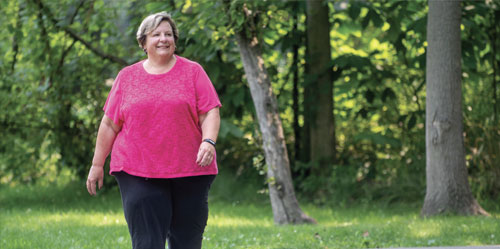Could You Have Prediabetes?

By Jill Yore
When Judy Gombar of Sterling Heights was diagnosed with prediabetes, her doctor referred her to a diabetes prevention program, where she learned about how to read nutrition labels, make better food choices and focus on becoming more active. A year later, her overall health is much improved. She’s lost more than 40 pounds, lowered her A1C and blood pressure, and has been able to discontinue some medications.
Approximately 88 million American adults have prediabetes and more than 84 percent of them don’t know it. Prediabetes means you have a higher than normal blood sugar level. It’s not high enough to be considered type 2 diabetes yet, but without lifestyle changes, adults and children with prediabetes are more likely to develop type 2 diabetes.
While the cause of prediabetes is unknown, family history and genetics play an important role. A lack of regular physical activity and being overweight, with excess fat around your abdomen, are also important factors.
When an individual has prediabetes, their cells do not respond normally to insulin, which lowers blood sugar. The pancreas makes more insulin to try to get the cells to respond.
Eventually, the pancreas cannot keep up with the demand, and blood sugar rises, setting the stage for prediabetes. When insulin levels rise, it interferes with burning fat. Without lifestyle changes, the result can lead to type 2 diabetes.
You may have prediabetes for years with no symptoms. However, some warning signs to watch for include fatigue with no physical exertion, slow healing wounds, vision problems, unexpected weight increase, frequent urge to urinate, indigestion/heartburn and even sugar cravings.
Healthy lifestyle choices can help you prevent prediabetes and its progression to type 2 diabetes — even if diabetes runs in your family.
Try to:
❏ Eat healthy, low-fat, high-fi ber foods. Fiber can slow the absorption of sugar.
❏ Get at least 150 minutes of moderate aerobic physical activity a week, or about 30 minutes on most days of the week.
❏ Lose excess weight.
❏ Don’t smoke. Nicotine can interfere with insulin levels causing smokers to need more insulin.
❏ Choose water instead of sugary drinks.
The American Diabetes Association (ADA) recommends that diabetes screening begin at age 45, or earlier if you’re overweight and have additional risk factors. Risk factors include weight (being overweight or obese is a main risk factor), inactivity (the less active you are, the greater your risk), family history and race. (African American, Hispanic, Native American, Asian American and Pacifi c Islanders are at higher risk.)
The most serious consequence of prediabetes is progression to type 2 diabetes. Prediabetes has been linked with unrecognized (silent) heart attacks and can damage your kidneys.
Jill Yore is the Director of Faith and Community Health at Henry Ford Macomb Hospital. Henry Ford Macomb Hospital offers a free, yearlong lifestyle change program for qualifi ed people at risk of developing diabetes. Call (800) 532-2411 or email [email protected].

